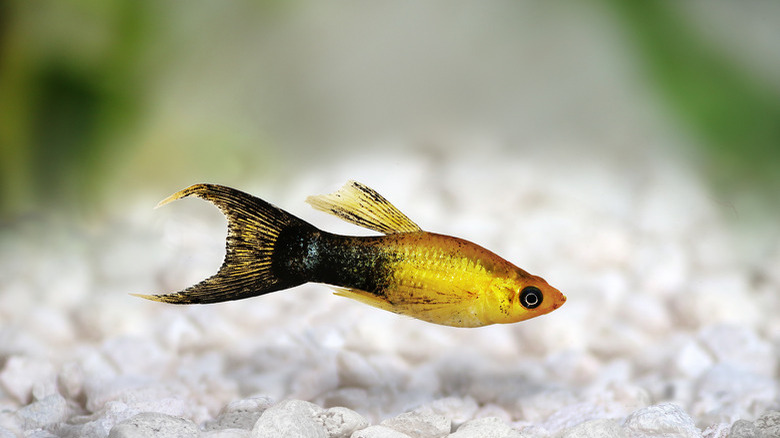How To Cure Swim Bladder Disease In Molly Fish
We may receive a commission on purchases made from links.
Disclosure: At Cuteness, we are committed to being the go-to resource for pet owners and animal lovers. We only recommend products we think our audience will love. If you purchase something by clicking on one of these links, we may receive a small commission of the sale and the retailer might receive some data for accounting purposes.
Mollies make an excellent choice for novice aquarium owners as they are hardy freshwater fish, come in a variety of colors, and can live in an aquarium as small as 10 gallons. The species is fun to watch as they fin their way gracefully around the tank. Because they're usually on the move, unusual things like a motionless molly listing off to one side or the freshwater fish swimming upside down are readily noticeable. Don't assume she's dying; although swim bladder disease in molly fish can be fatal, with early detection and treatment, your fish has a good chance for survival.
Swim bladder function
Your fish's swim bladder lies deep within his body as an offshoot of the digestive tube. The bladder contains gas, including oxygen, that lets the fish float upright at the desired depth. When the swim bladder malfunctions, the fish has trouble maintaining his level in the water and can sink to the bottom of the tank or be stuck near the top. The abnormal ballast can cause the fish to turn sidewise and swim on his side, or even roll entirely upside down.
Swim bladder disorder causes
Swim bladder disorder often results from other organs pushing on the swim bladder, thereby disrupting its function. Overeating and constipation are the first two things to suspect, especially if you leave food floating on the top of the tank after your fish have had two-to-three minutes to feed. Fatty liver disease, kidney problems, or impacted eggs are other physical causes of floatation problems. Finally, bacterial counts in the tank, parasites, or high levels of nitrates can also be at fault.
Initial treatment: First 48 hours
Check the temperature of your tank. If you tend to keep it on the cold side of the 70-to-85-degrees Fahrenheit water temperature recommended for mollies, turn it up to at least 80 degrees. Low temperatures can cause digestive issues in fish, so chances are your entire molly community will benefit from added warmth. If your molly isn't interested in feeding and the other fish are leaving her alone, it's not necessary to remove her from the community tank. However, if you recently introduced the fish to the community and bacteria could be at fault, isolate her in a hospital tank immediately to minimize exposure to other tank mates. Don't feed the sick fish for the first 48 hours to allow her to process what is already in her digestive tract. In many instances, the fish will return to normal during this timeframe.
Further swim bladder disease treatment
If your fish hasn't recovered or shown significant improvement within 48 hours, administer continued therapy in a separate tank. Put your fish on a high-fiber diet consisting of a peeled, cooked pea so the extra roughage can help clear constipation. Let the fish nibble the pea for two-to-three minutes and then remove until the next feeding. Offer your fish a peeled, cooked pea up to three times a day and continue withholding regular fish food.
Add one tablespoon of aquarium salt for every 5 gallons of water in the molly's recovery tank as a salt treatment. Make sure to use aquarium salt designated for use in a freshwater aquarium, such as API aquarium salt, readily available on Amazon. The salt kills bacteria that contribute to swim bladder disease.
Alternatively, you could treat the water with an antibacterial formula to take care of any tank bacteria causing the infection. Should your fish need further swim bladder disease treatment, take him to a fish vet to see if he needs swim bladder medication.
Preventing a recurrence
Water quality is the factor most common in any fish disease, and swim bladder disorder is no exception. Fish suffer stress when their water quality is poor, such as if the pH is off, the temperature is too cold, or there are too many nitrates. Such factors disrupt their bodies' homeostasis, leaving them vulnerable to buoyancy problems and other disorders.
